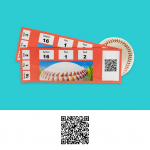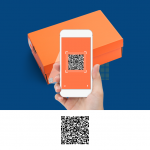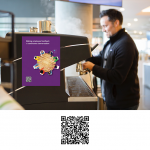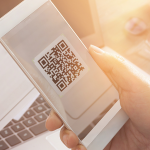Let’s suppose you’re a retailer and you want to gather feedback from your customers. One way is to include a URL on the sales receipt that takes people to a survey. The problem with this is that it only works if they remember to do it when they get to a computer. It also requires people to type in a possibly long and complex URL correctly, which is a bit risky.
Or what if you’re holding a conference, an event or a concert, and you want to know whether it was a hit with the audience? It's likely that you won’t be able to reach many people via digital means, but what if you could give them quick access to a survey on the spot that only requires them to take photo of an image with their smartphones?
Collecting feedback really can be that frictionless. With QR codes, you have countless new ways to connect with your respondents, especially when sharing surveys digitally isn’t an option.
QR codes – now at SurveyMonkey!
You’ve almost certainly already seen QR codes – small black and white squares that look like some sort of secret code – and these are an extremely convenient way to send people to a website. For a long time, QR codes required special apps, which may have been part of the reason why they were slow to gain popularity in the UK. And in the US, a Comscore study showed that only 6.2% of Americans with mobile phones took a photo of a QR code in June 2011. In other parts of the world, though, adoption has been huge.
The massive popularity of QR codes in China and Japan has been credited as the reason for advancements in this technology. Now, using QR codes to access a website (or, in this case, a survey) is as easy as taking a photo with most smart mobile devices.
With ease comes popularity, and QR codes have now started to crop up everywhere, from social media to bike-sharing services to products that provide easy access to user manuals. And, as you may have guessed, you can even use QR codes to collect responses to your SurveyMonkey surveys!
Take your survey to where your audience is
What does being able to collect survey responses with a QR code mean for you? It means that you now have another way to reach even more survey-takers. Until now, it's been easy to share surveys digitally, but now you can also share them in the physical world: from posters to pamphlets to product packaging and more.
- Are you holding an event or conference and want to get feedback on it? If so, post your QR code in gathering areas so that event-goers can take the survey right there and then while the experience is still fresh in their minds. It’s a great way to gather more feedback on the spot and with minimal effort or resources.

- Do you own a business and want to know what your customers think? If so, why not post a QR code on receipts, menus or your product packaging? You’ll catch them when the experience is fresh in their minds and before they move onto their next task of the day.

- Do you want to know what’s on your employees’ minds? If so, why not put up a poster near the coffee machine displaying a QR code that links to an employee engagement survey? That will almost certainly capture the attention of a lot of people!

- Maybe you’re a teacher doing a presentation for a group of students and need to give them access to a SurveyMonkey survey or a quiz. Just add a QR code to your slides so participants can use their smartphones to take a photo of it for quick and easy distribution.

Select, download, done
Now you can see how beneficial and convenient it is to use a QR code for gathering feedback from people in a non-digital way, let’s talk about how easy it is to create and share one.
Once your survey is complete and you’re ready to share it with the world, you can obtain a QR code in three (or four) quick steps:
- Click COLLECT RESPONSES.
- Select Web Link.
- If you like, you can customise the URL that respondents see.
- Click the grey DOWNLOAD QR CODE button.

That’s all there is to it!
Now you can start placing that QR code image anywhere your needs, and creativity, call for.
TIP: A lot of smartphones now have a QR code reader built into the camera app. For those that don’t, a QR reader can easily be downloaded onto a device.
Learn more about how to use QR codes to collect survey responses.



